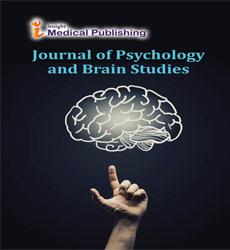Later-life Depression and Anxiety Disorders
Sushree Sunena*
Department of Psychology, Utkal University, Bhubaneswar, Odisha, India
- *Corresponding Author:
- Sushree Sunena
Department of Psychology
Utkal University
Bhubaneswar, Odisha, India
E mail: sushreesunena04@gmail.com
Received Date: September 07, 2021; Accepted Date: September 12, 2021; Published Date: September 17, 2021
Citation: Sunena S (2021) Later-life Depression and Anxiety Disorders. J Psychol Brain Stud Vol. 5 No.9:41.
Editorial
The elderly population is rapidly increasing. Accurate information on psychiatric problems in this group is needed to make the best use of limited health-care resources. Anxiety disorders in the elderly have gotten far less research than depression or dementia to date. Social isolation, decreased autonomy, financial insecurity, poor health, and imminent death, all of which are associated with ageing, may be expected to increase the prevalence of anxiety in later life. Anxiety disorders, on the other hand, account for just a small percentage of mental hospital admissions among patients over the age of 65, and anxiety disorders are on the decline among senior hospital outpatients. However, it is possible that older people suffering from anxiety do not seek medical help or is misdiagnosed, resulting in concealed morbidity. Community- based epidemiologic surveys are more likely to offer more precise data on the extent of anxiety in the elderly, making treatment planning, service delivery, and possibly prevention easier. As a result, the goal of this paper is to compile and review the existing epidemiologic data on late-life anxiety disorders.
The increased intensity and poorer treatment response in those with comorbid anxiety and depression than in that with either disorder alone is an important therapeutic argument for studying comorbidity of depression and anxiety. There is presently a push to look into the comorbidity of anxiety and depression in older populations. This push is due in part to a growth in the senior population; in the United States, the elderly population (aged 65+) is predicted to double in size over the next 30 years, with a similar increase in the 85+ age category. Another source of motivation is research that shows how psychiatric diseases vary substantially over the age in terms of risk factors, presentation, comorbidity, and illness course. In many cases, late-onset depression, for example, appears to have a cerebrovascular aetiology. This "vascular depression" hypothesis proposes that some cases of late-onset depression are caused by cerebrovascular disease- induced disruptions in mood regulating circuits.
Similarly, the high prevalence of depression in the early stages of Alzheimer's disease (AD) shows that depressed symptoms in later life could be a sign of a neurodegenerative disease. As a result, the pathophysiology of late-life depression differs significantly from that of young-adult depression. The same is true for late- life anxiety disorders, which appear to be infrequent in the community senior population when examined with standard diagnostic measures designed for adults but are substantially more common when using geriatric-specific assessments. As a result, the comorbidity of depression and anxiety disorders in later life may differ from that of younger persons, necessitating further research.
Despite this rationale, there has been little research on the risk factors, phenomenology, course, or therapy of late-life anxiety disorders, or their comorbidity with late-life depression. Review of the research on the epidemiology, risk factors, cross-sectional presentation, relationships with disability and death, and course of comorbid depression and anxiety (both as a symptom and as a separate diagnosis) in the elderly. We present new evidence that comorbid anxiety disorders are more common in depressed elderly people than previously thought, and that depression with anxiety symptoms or a comorbid anxiety disorder in the elderly is a more severe illness in terms of course and outcome than depression without anxiety. We assess depression with concomitant anxiety and make therapy suggestions. Finally, we urge that clinical research into the comorbidity of late-life depression and anxiety be directed in this area.
Open Access Journals
- Aquaculture & Veterinary Science
- Chemistry & Chemical Sciences
- Clinical Sciences
- Engineering
- General Science
- Genetics & Molecular Biology
- Health Care & Nursing
- Immunology & Microbiology
- Materials Science
- Mathematics & Physics
- Medical Sciences
- Neurology & Psychiatry
- Oncology & Cancer Science
- Pharmaceutical Sciences
